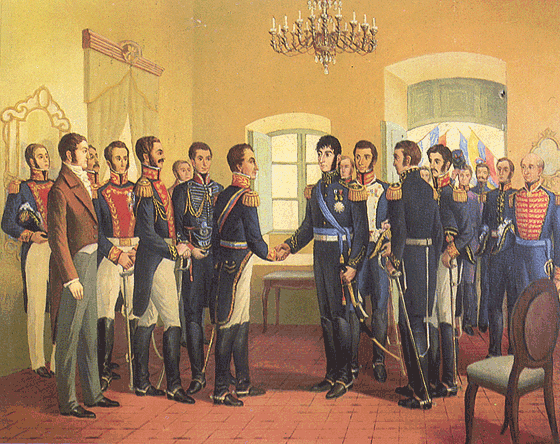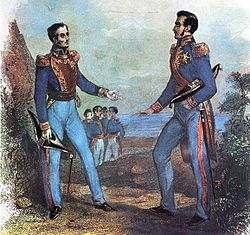|
| |||||||||||||||||||||||||||||||||||||||||||||||||||||||||||||||||||||||||||||||||||||||||||||||||||||||||||||||||||||||||||||||||||||
Entrevista de Guayaquil
La entrevista de Guayaquil se refiere a la reunión entre los libertadores de América, Simón Bolívar y José de San Martín en laCiudad de Guayaquil, el 26 de julio de 1822.
Se efectuó con propósito de discutir la soberanía sobre la provincia de Guayas, el destino del Perú y en forma general el deAmérica del Sur.
Antecedentes
El 24 de mayo de 1822, Sucre derrota a los realistas en Pichincha y ocupa Quito el 25 de mayo. El contingente peruano que intervino en esta batalla, estuvo compuesto por 1.600 efectivos al mando del coronel Andrés de Santa Cruz y se unió a la tropa patriota grancolombiana en Saraguro el 9 de febrero de 1822. Posteriormente, Simón Bolívar presiona diplomáticamente a Guayaquil, con el fin de anexarla a la Gran Colombia. Tanto el Libertador del Norte, general Simón Bolívar como el Libertador del Sur, general José de San Martín, estaban convencidos que la definición de la independencia americana tenía que darse en suelo peruano, por lo que el propósito de Simón Bolívar era llegar al Perú.
Antes de los sucesos de Guayaquil, San Martín había convocado al Primer Congreso Constituyente de la República del Perú, el 1 de mayo de 1822. Se eligieron 79 diputados, instalándose este legislativo el 20 de septiembre de 1822 solemnemente. Luego de la instalación y en la misma fecha, este Congreso ofreció al general José de San Martín poderes dictatoriales, los cuales rehusó. Se varió el ofrecimiento al de Fundador de la Libertad del Perú y Generalísimo de las Armas, título que fue aceptado por el general San Martín, aunque de manera honorífica. Su decisión de retirarse era terminante. El Congreso así instalado eligió como su Presidente a Francisco Xavier de Luna Pizarro.
La independencia de Guayaquil
Después del 9 de octubre de 1820, Guayaquil, de la mano de José Joaquín de Olmedo y otros patriotas, alcanzó su independencia de España. Más tarde, en el mismo año, se crearía la nueva nación de la Provincia Libre de Guayaquil, cuyo presidente fue Olmedo.
Después de la gesta libertaria, José Joaquín de Olmedo pidió ayuda a Simón Bolívar para asegurar la independencia de la ciudad y seguir con la independencia de lo que una vez fue laReal Audiencia de Quito. Bolívar envió al mejor de sus generales, Antonio José de Sucre, con cientos de soldados a favor de la causa emancipadora.
Sucre firma un tratado con los guayaquileños que coloca a la ciudad bajo la protección de Colombia, luego reorganiza sus fuerzas y entre otras acciones vence en las faldas del Pichincha, el 24 de mayo de 1822; un día después, ocupa Quito. Una vez liberada, la Presidencia de Quito, decide seguir los pasos de otras naciones para conformar un estado único, la República, que en homenaje a Cristóbal Colón, debería llamarse Colombia, y de la cual fue elegido presidente Simón Bolívar. Para estas campañas Bolívar pide ayuda a San Martín, quien le envía 1.600 soldados que participaron en Riobamba y Pichincha .1
Después de cinco días de la victoria en las faldas del Pichincha, Quito convino con la anexión y declaró la incorporación de todo el territorio que constituyó la Real Audiencia de Quito.Cuenca y Loja aceptaron inmediatamente esta decisión.
El problema era que La Provincia Libre de Guayaquil, yacía como estado soberano aunque no reconocido aún. Además en Guayaquil surgierón tres partidos políticos:
- Los colombianistas: partidarios de que Guayaquil se anexe a la Gran Colombia.
- Los peruanistas: partidarios de que Guayaquil se anexe a la República del Perú.
- Los independientes: partidarios de que La Provincia Libre de Guayaquil sea estado soberado e independiente, tales como José Joaquín de Olmedo.
Ante el peligro de mantener un núcleo realista en América, Bolívar acepta la invitación de San Martín para unir fuerzas, eligiendo Bolívar la ciudad de Guayaquil para la entrevista.2
El 11 de julio de 1822, Bolívar llegó a Guayaquil para decidir sobre la incorporación a Colombia. En un comienzo, pretendía que la incorporación se hiciera por el voto libre y espontáneo pero debido a que un grupo de ricos comerciantes querían perpetuarse en el mando (y de no conseguirlo, unirse al Perú), Simón Bolívar asumió todos los poderes y tomó la ciudad deSantiago de Guayaquil bajo la protección de la República de Colombia, asumiendo el mando político y militar.
La entrevista de Guayaquil
Pocos días después llegó San Martín con sus edecanes y escolta, al mando de Pedro Nolasco Fonseca, y sostuvo una reunión conBolívar, a solas y sin testigos, donde trataron principalmente tres cuestiones: el destino de la Provincia de Guayaquil, la reparación de la ayuda que el Perú había brindado anteriormente para la liberación de aquella provincia, y el final de la campaña contra los realistas, cuya definitiva etapa debía librarse en Perú.
La noche del 27 de julio de 1822, Bolívar agasajó a San Martín con un banquete. A mitad del mismo, y bajo un estricto secreto de todo lo conversado, tal cual lo convenido, San Martín se retiró hacia el muelle, y se embarcó hacia el Perú.
Eventos posteriores
La anexión obligada de La Provincia Libre de Guayaquil a la Gran Colombia, provocó el auto exilio de José Joaquín de Olmedo, quien en una conmovedora misiva le hizo conocer a Bolívar su desacuerdo con las medidas adoptadas con su pueblo. El 31 de julio de 1822, la ciudad de Santiago de Guayaquil declaró su anexión a la Gran Colombia y con ella también el resto de la agonizante nación guayaquileña.
Al llegar San Martín a Perú se retiró a todos de campo. Acompañado por una pequeña escolta y un ayudante, esa misma noche, montado a caballo, se dirigió a Ancón, al norte de Lima. Era el 20 de septiembre de 1822, el mismo día de la instalación del Primer Congreso Constituyente de la República del Perú. En la madrugada del día 22 de septiembre, en el bergantín “Belgrano”, se embarcó rumbo a Valparaíso.
El Protectorado de San Martín fue sucedido por una Junta de Gobierno, integrada por el general José de La Mar, el comerciante Felipe Antonio Alvarado y el conde Manuel Salazar y Baquíjano. El Primer Congreso Constituyente promulgó el 12 de noviembre de 1822, la Primera Constitución Política de la República, de clara tendencia liberal. Fue una constituciónefímera; ahora que San Martín había desaparecido de la escena, Bolivar si accedió a dirigir sus fuerzas en ayuda del Perú. Así, a la llegada de Simón Bolívar, el propio Congreso Constituyente, tuvo que suspender sus efectos para poder dar plenos poderes dictatoriales a Bolívar.





 Triumphant: campaigners won a landmark victory at the Court of Appeal last year
Triumphant: campaigners won a landmark victory at the Court of Appeal last year










No comments:
Post a Comment